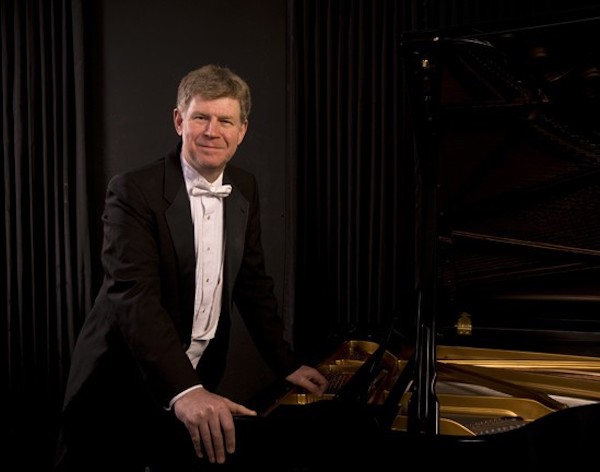Hobson continues Schumann piano series with varied and successful program
If you were lucky enough to fall in love with classical music as a teenager, there’s a good chance your main man was Robert Schumann, who was still in his teens himself when he started the unbroken run of wildly Romantic piano compositions that extended from his Opus 1 to Opus 23. When the mood was upon him, youthful visions of masked balls and champagne and falling in love tumbled out as keyboard gems, sometimes two or three a day, that he strung together in cycles with titles like Papillons and Carnaval.
Schumann’s contemporaries hardly knew what to make of these “albums,” or the fleeting pieces in them, so full of sudden mood swings and bizarre modulations. It is still a challenge for the performer to leave logic at the door and simply plunge into the corridors of Schumann’s imagination.
Pianist Ian Hobson answered that challenge with considerable success in no fewer than four of Schumann’s piano cycles Tuesday night at St. Bartholomew’s Church, in a program with the overall title “Carnival Jests.” The venue was actually the church’s small side chapel, an intimate but high-ceilinged room with a rather live acoustic; those who arrived early enough to snag a pew near the front had a favorable signal-to-reverb ratio, minimizing blurring.
It didn’t help that Hobson, a formidable technician, often let his fingers run away with him in the early going, turning the more excitable passages of the Intermezzi, Op. 4, into an arhythmic blur. But he was alert to Schumann’s volatile moods and novel piano textures, as when the composer mirrored the fourth movement’s “shepherd boy” tune at the interval of a 15th (two octaves).
It was a smart choice to open the program—as in the first, pre-pandemic recital in Hobson’s Schumann series—with a lesser-known work, so that even knowledgeable piano fans could start fresh with this familiar composer. The phrase “unjustly neglected” came to mind often as attractive tunes alternated with furious prestos over the set of six brief intermezzi. (Later, the idea of a standalone piece whose title means “in between” so appealed to Brahms that he called about half of his superb late piano pieces “intermezzi.”)
It was during a visit to Vienna during carnival season (known there as Fasching) that Schumann conceived a “grand Romantic sonata,” later giving it the un-grand title Faschingsschwank aus Wien (Carnival Jest from Vienna), Op. 26. The piece’s five-movement scheme is indeed sonata-like, with a lengthy first movement, contrasting inner movements, and a brilliant finale.
In Hobson’s performance, the first movement, a Schubertian waltz medley, vibrated with Schumannian nervous energy, which tended to push the Viennese 3/4 meter out of shape. But the pianist tripped the light fantastic in the brief Scherzino, unleashed the burgeoning fervor of the Intermezzo, and brought the hot Finale home with commanding technique.
Hobson proved his stamina by closing this intermissionless recital with back-to-back renditions of Papillons and the even-more-challenging Carnaval, with just a brief pause for a bow in between. These were, furthermore, his most successful performances of the night in depth of expression, rhythmic vitality, and piano tone and voicing.
On fire with Romantic literature, and specifically a masked-ball scene from Jean Paul’s novel Flegeljahre (The Indiscreet Years), the 19-year-old Schumann spun a dozen waltzes and polonaises into Papillons, Op. 2. Hobson made these vignettes prance, sigh, and sparkle in vivid impressions. (There was no missing the character who came to the party dressed as a giant boot.)
Segueing directly into Carnaval, Op. 9, pointed up the family resemblance between these two ballroom scenes, but also the far grander conception of the latter, both pianistically and expressively. The splendid summons of Carnaval’s Préambule established the work’s (and this performance’s) wider horizons right away.
This time the composer populated the party with characters not from a book but from his own world: music superstars (Chopin and Paganini), girlfriends (Clara and her rivals), commedia dell’arte characters, Schumann’s own split persona as the fiery Florestan and the dreamy Eusebius, and finally his radical gang, the “David League,” marching (in 3/4 time!) against musical philistines.
Hobson brought the whirl of personalities to energetic life. The dizzy scene could have used a few more pauses to reflect, like the charming moment with the sad-sack clown Pierrot, but it did give scope to Hobson’s technical wizardry, culminating most excitingly in the Davidsbündler’s exuberant charge to the end.
